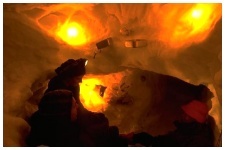
 Snow Caves - If They Work for the Bears...
Snow caves can provide both an emergency and recreational winter shelter. Snow is a very good insulator, and when properly made, the inside of a snow cave will stay at a cosy 32°F / 0°C. A single lit candle can increase the temperature substantially, much like a kudlik would do in an igloo.
The inside should be shaped like a dome (like an igloo) to add stability and insulation, and the walls should be at least 12 inches / 30 cm thick. The smoother the walls are, the less likely the cave will drip as the temperature rises inside. This is important - bore a ventilation hole (at least 2 inches / 5 cm in diameter) into the top of the cave with a pole or stick. This allows for the release of carbon dioxide and carbon monoxide that build up from breathing or burning of candles and cook stoves. Without ventilation, these gasses can accumulate and asphyxiate (smother or suffocate) everyone inside.
Click pictures for more information and credits. Library: Arctic, Snow, Cold/Cold Places Inuit, Health/Safety Links: Arctic, Inuit, Cold Places Dig a Snow Cave Arctic Maps & Weather Reports |

|
DICTIONARY: Just "double-click" any unlinked word on this page for the definition from Merriam-Webster's Student Electronic Dictionary at Word Central. |

|
ARCTIC LIBRARY & GLOSSARY: Check this section for an index of the rest of the things you really need to know about the Arctic. |

|
ARCTIC MAPS & WEATHER REPORTS: Maps of the Northwest Passage, explorers' routes, iceberg sources, Nunavut, the Arctic by treeline, temperature... |

|
ARCTIC LINKS: Even more information! Links to sites related to the Arctic and "Iceberg: the Story of the Throps and the Squallhoots". |

|
GUIDE TO ARCTIC SUNRISE & SUNSET: How much sunlight or darkness is there in the Arctic on each day of the year? |
to is the property of their respective owners, and Athropolis is not responsible for their content.
